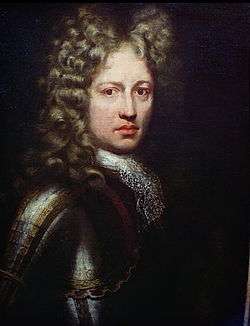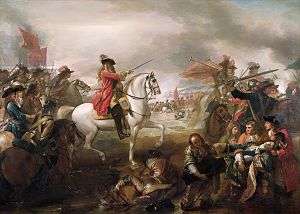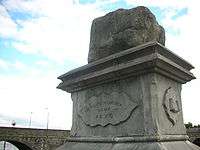Patrick Sarsfield, 1st Earl of Lucan
| The Rt Hon. The 1st Earl of Lucan | |
|---|---|
 | |
| Born |
ca. 1660 Lucan, Ireland |
| Died |
21 August 1693 (aged about 33) Huy, France (now in modern Belgium) |
| Buried | St. Martin's Church, Huy, Belgium |
| Allegiance |
Ireland (1682–88) Jacobites (1688–91) France (1691–93) |
| Rank | Lieutenant General |
| Battles/wars | Battle of Sedgemoor, Battle of the Boyne, Siege of Limerick, Battle of Landen |
| Spouse(s) | Honora Burke |
| Children | James Sarsfield, 2nd Earl of Lucan |
Patrick Sarsfield, 1st Earl of Lucan (ca. 1660 – 21 August 1693), was an Irish Jacobite and soldier, belonging to an Anglo-Norman family long settled in Ireland.[1]
Sarsfield gained his first military experience serving with an Anglo-Irish contingent of the French Army during the 1670s. When James II came to the throne he was commissioned in the English Army, and served during the suppression of Monmouth's Rebellion in 1685. During the Glorious Revolution of 1688 he remained loyal to James and led an English cavalry detachment at the Wincanton Skirmish, the only military engagement of the campaign.
In 1689 Sarsfield accompanied James to Ireland and served in the Jacobite Irish Army. After an early setback at Sligo, he became one of the celebrated Jacobite leaders of the war, noted in particular for Sarsfield's Raid shortly before the Siege of Limerick in 1690. James rewarded him by making him an Earl in the Peerage of Ireland. After the war's end following a second siege of Limerick in 1691, he led the Flight of the Wild Geese which took thousands of Irish soldiers into exile in France where they continued to serve James. After a planned invasion of England had to be abandoned following a French naval defeat in 1692, Lord Lucan (as he then was) served in Flanders and was killed at the Battle of Landen in 1693.
Background
Sarsfield was born in Lucan c. 1660. His family were a mix of Norman Irish and Irish Gaels. His father was Patrick Sarsfield and his mother was Anne O'More. Among his grandparents he counted Ruairí Ó Mórdha (who was a key organiser of the Irish Rebellion of 1641), and Eibhlín Ní Dhíomasaigh from the Viscount Clanmalier family. The extended family of the powerful family of O'Mores, an estimated 120 people, had been virtually wiped out by the English during the Massacre of Mullaghmast.
His paternal family were Roman Catholics of Norman origin (by this time the origin was known as "Old English") and possessed an estate with an income of £2,000 a year. His father had been implicated in the 1641 Rebellion, supported the Irish Confederacy during the subsequent war, and assisted the Anglo-Irish Royalist forces against the English Republicans during the Siege of Dublin. Following the Cromwellian conquest of Ireland Patrick Sarsfield senior had his Leinster estates confiscated, and was transplanted to Connacht where he was given a smaller estate. Some sources suggest that his son Patrick was born while the family was in the west of Ireland.
Following the Restoration of Charles II in 1660, the Sarsfields made attempts to recover their lost estates but the Court of Claims found them guilty of taking part in the initial rebellion. The family's fortunes were boosted by the marriage of Patrick's elder brother William Sarsfield to Mary Crofts, who was widely believed to be an illegitimate daughter of King Charles and Lucy Walter, and the younger sister of James Scott, Duke of Monmouth. The King now intervened on behalf of the Sarsfields, and agreed to a compromise: Lucan Manor would be restored to the Sarsfield family after the death of its current occupant, Colonel Theophilus Jones.
Following the death of his nephew Charles Sarsfield, Patrick advanced his own claim to Lucan Manor with the legal assistance of his cousin Francis Sarsfield.
Early military career
Patrick, as a younger son, sought a career as a soldier. His first experience may have been some brief time spent with the Irish Guards in Dublin. Although Catholics were notionally forbidden from military service, the ranks of the Guards were frequently an exception.[2]
He entered Dongan's Regiment of Foot on 6 February 1678.[1]
In his early years he is known to have challenged Lord Grey for a supposed reflection on the veracity of the Irish people (September 1681), and in the December of that year he was run through the body in a duel in which he engaged as second.[1]
In 1682–83 while in London, Sarsfield took part in two abductions of heiresses. In May 1682 he helped his friend Captain Robert Clifford to abduct Ann Siderlin, a wealthy widow, and was considered lucky not to be prosecuted. Then he abducted Elizabeth Herbert, the widowed daughter of Lord Chandos, on his own account. Elizabeth refused to marry him, but agreed not to prosecute him in exchange for her freedom.[3]
During the last years of the reign of Charles II he saw service in the English regiments that were attached to the army of Louis XIV of France. The accession of James II led to his return home.[1]
Monmouth's Rebellion
He took part in the suppression of the Monmouth Rebellion in 1685. After Monmouth had landed in the West Country and proclaimed himself King in defiance of James, Sarsfield was given permission to accompany the Royal Army as a gentleman volunteer. He was wounded with a sword slash to the hand during a skirmish with the rebels at Keynsham.[4] He was present again at the decisive victory at the Battle of Sedgemoor on 6 July 1685. During the fighting he was knocked off his horse, clubbed by muskets and left for dead by the rebel infantry. Wounded in several places, he nonetheless survived, and the battle gained him recognition for his conduct. His actions were even brought to the attention of the King.[5]
As a reward he was formally given a commission, appointed as a Captain in Richard Hamilton's regiment of the Irish Army. However before he could take up this position he was transferred to an English cavalry regiment and promoted to Major.[6] In the following year, he was promoted to a Colonelcy.
Glorious Revolution
During the Glorious Revolution of 1688, Sarsfield remained loyal to James. While other officers defected to the invading Dutch Army, Sarsfield was active on the King's behalf, and fought the Wincanton Skirmish against an enemy detachment.
King James had remodelled the Irish army from a Protestant-led force to a Catholic-led one, and Sarsfield, whose family was Roman Catholic,[1] was selected to assist in this reorganisation. He went to Ireland with Richard Talbot, 1st Earl of Tyrconnell, who was appointed commander-in-chief by the King.[1]
Williamite war 1689–1691

In 1688 the death of his elder brother, who had no son, made Sarsfield the heir to the family estate, which brought him little money while he was on the losing side of a civil war.
Sarsfield sat in the 1689 Patriot Parliament as a member for Dublin County.
The Catholic King James came into Ireland with the backing of Louis XIV attempting to regain his throne from his son-in-law, the Protestant William of Orange. William had been invited to invade England by a group of influential political and religious leaders in what became known in England as the "Glorious Revolution", in 1688. Louis XIV was the terror of Europe at this time, spreading French hegemony across the continent.
Most Irish people supported James because of his 1687 Declaration of Indulgence or, as it is also known, the Declaration for the Liberty of Conscience, which granted religious freedom to all denominations in England and Scotland. James had promised the Irish Parliament an eventual right to self-determination.
For the Catholic and Anglo-Irish in Ireland (also known as Gall or More Irish than the Irish themselves), the invasions by thousands of 'planters' during the preceding century in the Elizabethan and Cromwellian Plantations threatened to dispossess them. They feared for their lives and their property and rallied around James and his promises of tolerance for all religions.
Sarsfield came with King James in command of the Irish soldiers James brought.[1] King James's army also included French, Dutch, Danes, Swedes, and Prussians, or Brandenburghers. The Irish army was largely composed of recruits, little drilled and badly armed.[7] Sarsfield's soldiers were involved in battles with soldiers in the service of William of Orange through the streets of Reading and at Wincanton.[1]
During the earlier part of the Williamite war in Ireland, Sarsfield secured Connacht for the Jacobites.
The Battle of the Boyne (1 July 1690), in which the Pope backed and financed William of Orange as part of the Papal States while Louis XIV of France backed James to further his own imperial ambitions, was a disaster for Ireland, but Sarsfield emerged as its hero.
At the Boyne and also during the Siege of Limerick in August and September 1690, Sarsfield became prominent as a leader. He captured a convoy of military stores and artillery vital to the English at Ballyneety, near Pallasgreen between Limerick and Tipperary,[1] in a raid guided by a renowned rapparee, Galloping O'Hogan.[8] This delayed the siege of the town and flooding rains forced the English to retire.[1]
The 1st Duke of Berwick, King James's illegitimate son, jealously claimed that the achievement turned Sarsfield's head. It certainly made him the popular hero of the war. His generosity and courage had already commended Sarsfield to the affection of his people.

King James is said to have described him as a brave fellow who had no head, unlike himself since at the first intimation of defeat, James fled and was the very first to reach Dublin, 50 kilometres away. Sarsfield bitterly exclaimed: "Change kings and we will fight you over again",[9] as recorded by Gilbert Burnet.[10] (King James was forever after known in Ireland as Séamas a' Chaca, or James the Shit.)
On the evening after the battle, James's Irish supporters retreated in good order southwards through Duleek to Dublin. In the Vatican a Te Deum was sung in gratitude for King William's victory.
When James's cause was ruined, Sarsfield arranged the Treaty of Limerick and sailed to France on 22 December 1691, leading 19,000 of his countrymen to enter the French service in the first phase of the military denuding of Ireland known as the Flight of the Wild Geese. That year James created him Earl of Lucan,[11] and promoted him to the rank of brigadier and then to major-general.[1]
Death
Lord Lucan (as he was now) received a commission as lieutenant-general (maréchal-de-camp) from King Louis XIV of France. He fought with distinction in Flanders until he was mortally wounded at the Battle of Landen on 19 August 1693, less than two years later.[11] He died two or three days after the battle, at Huy, Belgium,[11] where he is buried in the grounds of St Martin's Church. A plaque on the wall of this church marks the approximate location of his grave. He was quoted as saying, while his lifeblood ebbed away, "Oh, if only this were for Ireland."[12]
Family
Sarsfield married Lady Honora Burke (or de Burgh), daughter of the 9th Earl of Clanricarde, on 9 January 1689 in Portumna Abbey.[13] They had one son, James Sarsfield, 2nd Earl of Lucan, who died childless in 1718.[11]
Sarsfield's widow married Charles II's illegitimate son, the 1st Duke of Berwick.[11] Berwick raised Sarsfield's only child James as his stepson.
Patrick Sarsfield is sometimes said to be the father of Catalina Sarsfield, the wife of German adventurer Theodor von Neuhoff, who briefly ruled as King of Corsica. She was in fact the daughter of David Sarsfield, a distant cousin of Patrick from the Cork branch of the family. Michael Corcoran, a Union general in the American Civil War, claimed maternal descent from Sarsfield.[14]
The title Earl of Lucan was recreated in 1795 for Sarsfield's great-nephew Charles Bingham.[15]
Legacy
Sarsfield is well commemorated in County Limerick. A figure of Patrick Sarsfield is on the coat of arms of County Limerick. One of the three main road bridges in Limerick is named Sarsfield Bridge; it adjoins Sarsfield Street. Sarsfield Barracks is the army barracks of Limerick. An 1881 bronze statue of Patrick Sarsfield by the sculptor John Lawlor in the grounds of St John's cathedral.[16]
Part of the route Sarsfield took for his daring attack on the Williamite siege train is marked out today as Sarsfield's Ride, and is a popular walking and cycling route through County Tipperary, County Clare and County Limerick. Sarsfield Rock, which overlooks the site of the attack, is marked by a plaque commemorating his victory
Sarsfield House, a large office block in Limerick, is the office of the Revenue Commissioners.[17]
Elsewhere in Ireland, a number of GAA clubs bear the name of Sarsfield. A fine portrait of Sarsfield by John Riley (1646–91) hangs in the National Gallery of Ireland.[18]
The town of Sarsfield in eastern Ontario was named in honour of Patrick Sarsfield in 1874.[19]
Part of the California Army National Guard, Bravo Company, 184th Infantry Regiment out of Dublin, California was called the Sarsfield Grenadier Guards at a time when the unit comprised soldiers of Irish birth or descent.[20]
The anonymous Irish poem "Slán le Pádraig Sáirséal" ("Farewell to Patrick Sarsfield") is considered a significant work of Irish-language literature.[21][22] The 19th-century song Jackets Green commemorates Sarsfield's soldiers and their loss to Ireland.
See also
Notes
- 1 2 3 4 5 6 7 8 9 10 11 Chisholm 1911, p. 223.
- ↑ Wauchope p.11
- ↑ Kelly 1994, p. 10 cites Wauchope 1992, pp. 22–26
- ↑ Wauchope p.29-30
- ↑ Wauchope p.30-32
- ↑ Wauchope p.33
- ↑ http://www.libraryireland.com/JoyceHistory/Boyne.php
- ↑ Todhunter 1895, p. 91.
- ↑ http://www.libraryireland.com/JoyceHistory/Boyne.php
- ↑ Wauchope 2004 cites Wauchope 1992
- 1 2 3 4 5 Chisholm 1911, pp. 223, 224.
- ↑ McCaffrey 2006, p. 106.
- ↑ Portumna Friary, Co Galway Secret Ireland: A Guide to Ireland's Historic and Cultural Treasures
- ↑ General Michael Corcoran (1827-1863) Fenian Graves
- ↑ The O'Byrne-O'Moore-Windsor Pedigree clanbyrne.com Archived 25 March 2012 at the Wayback Machine.
- ↑ "Dictionary of Irish Architects – lawlor, john *". Dia.ie. Retrieved 3 August 2013.
- ↑ http://www.revenue.ie/en/contact/collector-generals-division.html
- ↑ http://www.historyireland.com/early-modern-history-1500-1700/ballyneety/
- ↑ http://onlinecollection.nationalgallery.ie/view/objects/asitem/People@3141/12?t:state:flow=14832740-f8e0-4b2c-9ec5-20dbb7b16d16%5Bpermanent+dead+link%5D
- ↑ "California State Milita and National Guard Unit Histories Sarsfield Grenadier Guards". The California State Military Museum. Retrieved 24 November 2011. (Originally publisher March 1939 issue of California Guardsman)
- ↑ Kiberd, Declan (1979). Synge and the Irish Language. Springer. ISBN 9781349045709. Retrieved 30 December 2017.
- ↑ Craig, Patricia (2007). Asking for Trouble: The Story of an Escapade with Disproportionate Consequences. Blackstaff Press. ISBN 9780856408083.
References
- Kelly, James (1994). "The abduction of women of fortune in eighteenth-century Ireland". Eighteenth-century Ireland Journal. 9: 10.
- McCaffrey, Carmel (2006). In search of Ireland's heroes: the story of the Irish from the English invasion to the present day (illustrated ed.). Ivan R. Dee. p. 106. ISBN 978-1-56663-615-5.
- Wauchope, P. (1992). Patrick Sarsfield and the Williamite war.
- Wauchope, Piers (2004). "Sarsfield, Patrick, Jacobite first earl of Lucan (d. 1693)". Oxford Dictionary of National Biography. Oxford University Press. doi:10.1093/ref:odnb/24671.
- Todhunter, John (1895). Life of Patrick Sarsfield, earl of Lucan: with a short narrative of the principal events of the Jacobite war in Ireland. T.F. Unwin. pp. 88, 91.
- Attribution
![]()
Further reading
- See S McGarry, Irish Brigades Abroad (Dublin 2013)
- See J Todhunter, Life of Patrick Sarsfield (London, 1895).
- See Randal McDonnell, My Sword for Sarsfield (W. Tempest, Dundalgan Press, Dundalk, 1920).
| Peerage of Ireland | ||
|---|---|---|
| New creation | Earl of Lucan 1691–1693 |
Succeeded by James Sarsfield, 2nd Earl of Lucan |
External links
- Limerick City: A bit of History – The Treaty of Limerick
- Wild Geese Heritage Museum and Library
- Sarsfield Rock

- Works by or about Patrick Sarsfield, 1st Earl of Lucan in libraries (WorldCat catalog)